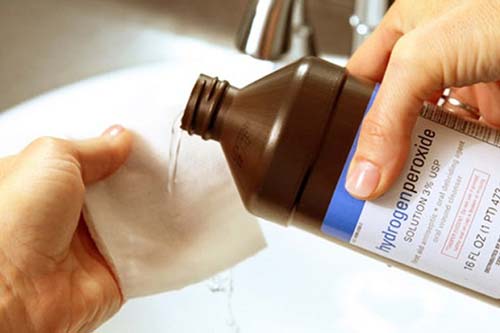Treating acne with hydrogen peroxide
Hydrogen peroxide, also known as oxygenated water, is a combination of water and oxygen. When this oxygen is released, it helps hydrogen peroxide have disinfecting and whitening properties. The oxidation process creates free radicals that attack the agents that cause diseases, including bacteria. In addition to its disinfecting properties, hydrogen peroxide also has antiviral and antibacterial properties.

Due to its strong oxidizing properties, hydrogen peroxide has antibacterial and disinfecting effects, reducing acne inflammation and promoting faster healing of acne.
When using hydrogen peroxide, oxygen molecules are released, triggering the oxidation process. It effectively treats acne, promotes skin regeneration, leaves the skin softer, and reduces acne marks.
Step 1: Dilute hydrogen peroxide with purified water and mix well.
Step 2: Cleanse the face with makeup remover and facial cleanser.
Gently pat dry the face with a clean, soft towel.
Step 3: Soak a cotton swab in the diluted hydrogen peroxide mixture and apply it to the acne spots. Note that hydrogen peroxide should not be applied to damp skin as it may reduce its effectiveness.
Step 4: Leave the mixture on the skin for about 5 minutes, then rinse the face with warm water to remove hydrogen peroxide from the skin.

Step 5: Gently pat dry the skin and proceed with further acne treatment or regular skincare routine.
It is recommended to use hydrogen peroxide for acne treatment a maximum of 2 times per week. Once the acne has improved, discontinuing its use is advisable.
Do not use hydrogen peroxide with a concentration higher than 3%. Higher concentrations can cause dryness, peeling, redness, and irritation.
Do not exfoliate the skin before applying hydrogen peroxide. Exfoliating the skin can make the new skin layer more susceptible to corrosion and cause skin burns.
Bathing with hydrogen peroxide
Mix 30ml of 3% hydrogen peroxide into the bathtub. Soak your body in the solution for about 30 minutes to cleanse and revitalize the skin. It can be done once a week. Rinse the body with warm water after soaking.
Foot soaking with diluted hydrogen peroxide can be done twice a week. Soaking the feet in diluted hydrogen peroxide helps eliminate bacteria that cause foot odor, disinfects, and helps prevent fungal infections between the toes.
Although hydrogen peroxide has high surface antibacterial and whitening properties, directly applying it to the skin is not safe and can cause complications such as dermatitis, burns, blisters, and redness. Therefore, it is important to research and understand the correct usage and safe dosage of hydrogen peroxide for effective results without harming the skin.






































